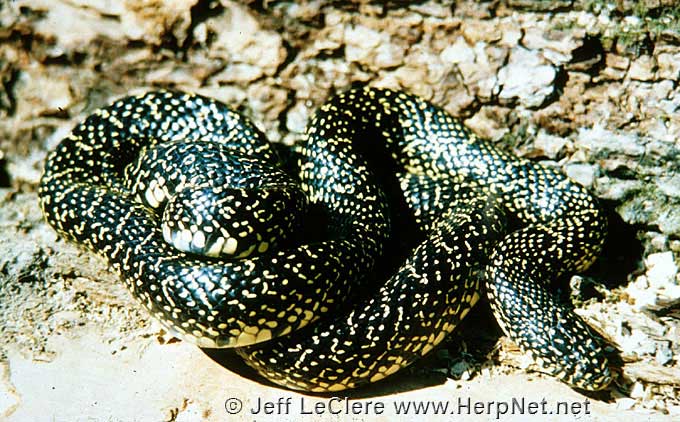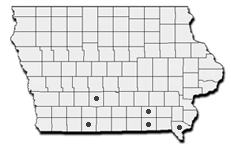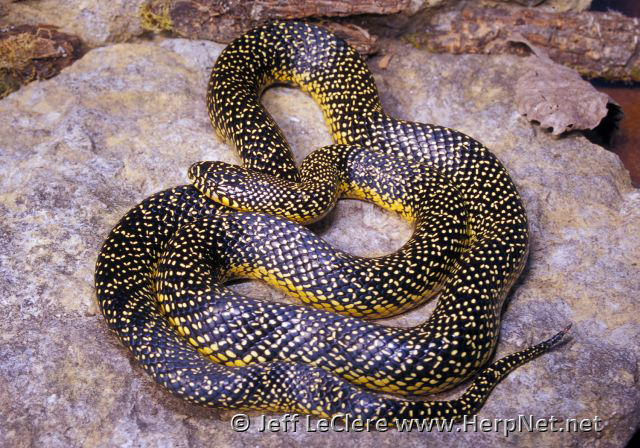Speckled Kingsnake (Lampropeltis holbrooki)
by Jeff LeClere

Status
THREATENED and Species of Greatest Conservation Need. It is illegal to kill or collect this species by law in Iowa. Records for this species are scattered in southern Iowa. Formerly listed as endangered. New locations provided by the public have been greatly appreciated. Any and all sightings of this snake are of interest and can be reported to us or the DNR.
Description
Harmless to humans. The speckled kingsnake is a medium sized Iowa snake that is 36 – 48 inches in length (Conant and Collins, 1991). This snake is shiny black with a yellow, yellowish green, or white spot on each scale. There is variation in the arrangement of these dots; some specimens have the dots arranged in such a way as to form a chain-like pattern on the back with speckling on the side of the snake. Others may be predominately black with a light sprinkling of dots. Some specimens may have the dots distributed evenly about the snake (this is how this kingsnake gets the local name “salt and pepper snake”). In any case, it cannot be confused with any other Iowa snake. The belly of the speckled kingsnake is white or yellow with clusters of black checkers; sometimes the belly ends up being more black than light. The scales are smooth and the anal plate is single.
Subspecies
No subspecies are currently recognized. The speckled kingsnake was formerly considered a subspecies of the common kingsnake, Lampropeltis getula.
Range
Speckled kingsnakes are found in the southern third of Iowa, but sightings are rare. In addition, to my knowledge, there is no concentration in Iowa. In other words, there is no place in Iowa where one could expect to find several of these snakes, even from known localities. A specimen just seems to show up every once in a while. If anyone finds a speckled kingsnake in Iowa, take a good photo, note the exact location, and report them to the DNR or us.


Habitat
These snakes utilize a wide variety of habitats. They are found in prairies, open grassland, fields, pastures, in ditches along cultivated fields and roads, woodlands, and some stream valleys and blufflands. They are most common in grasslands along forest edges. They also do not appear to be found deep in heavy woodlands very often. They are mainly found in open grassy or rocky areas in Iowa. They are a common snake in states south of Iowa, and use similar habitats there as well.
Habits
Speckled kingsnakes have a very similar natural history to prairie kingsnakes. Speckled kingsnakes are active from April to October in Missouri (Johnson, 1992). They are diurnal in the spring and fall becoming largely nocturnal in summer. Speckled kingsnakes are active snakes, wandering a great deal, but are still somewhat secretive. They are often seen on the roads in the morning or at dusk, and later after sunset in warm summer months. I have found specimens in Kansas after sunset. Individuals are rather passive when picked up, but a few will bite. They also release musk and vibrate their tails when agitated. Young specimens are particularly testy and will strike and musk freely when picked up.
Speckled kingsnakes mate soon after emergence from their hibernacula (Johnson, 1992). Collins (1993) reports combat behavior in males. The male will bite the neck of the female during courtship and retain a grasp on her neck during copulation. Females lay eggs in June or July. Smith (1961) reports a clutch size of 13 eggs. The eggs hatch in September. The young look like the adults, but the dots definitely form a chain-like pattern on the back. As the snakes grow, some will lose the pattern and the spots will even out, while others retain the pattern.
Food
Speckled kingsnakes closely resemble prairie kingsnakes in diet preferences. Kingsnakes are dietary generalists and feed on a wide variety of prey. Mammals, birds, birds eggs, snakes, lizards, frogs, and reptile eggs have been reported as food. Speckled kings, like other kingsnakes, will eat venomous snakes. Kingsnakes are immune to the venom of North American venomous snakes and venomous snakes will use other methods to escape kingsnakes. Instead of striking, the the venomous species will throw loops of coils at the kingsnake in an attempt to bat the kingsnake’s head and then escape quickly. Kingsnakes are even known to consume other kingsnakes.
Kingsnakes are powerful constrictors. These snakes are often found around farms and barns. They are looking for mice and other prey. They are very beneficial to farmers. Unfortunately, many people are ignorant of this fact and kill the snake believing it to be venomous. This is foolish; because of the snakes’ broad diet, the kingsnake will not only help rid the farmer of mice, but this harmless species will actually help rid the farmer of any venomous species that happen to be around as well. Also, speckled kingsnakes are a threatened species in Iowa and it is illegal to kill or harm them.
